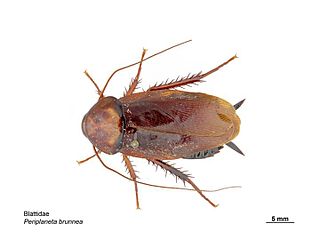
The brown cockroach is a species of cockroach in the family Blattidae. It is probably originally native to Africa, but today it has a circumtropical distribution, having been widely introduced. In cooler climates it can only survive indoors, and it is considered a household pest.

The red locust is a large grasshopper species found in sub-Saharan Africa. Its name refers to the colour of its hind wings. It is sometimes called the criquet nomade in French, due to its nomadic movements in the dry season. When it forms swarms, it is described as a locust.

The wart-biter is a bush-cricket in the family Tettigoniidae. Its common and scientific names derive from the eighteenth-century Swedish practice of allowing the crickets to nibble at warts to remove them.

Eurycnema goliath, commonly known as the goliath stick insect, or the regal stick insect, is a large species of stick insect in the family Phasmatidae, endemic to Australia and considered one of the largest species of stick insects in the country. The species has the Phasmid Study Group number PSG14.

Scopula marginepunctata, the mullein wave, is a moth of the family Geometridae. It was described by Johann August Ephraim Goeze in 1781. It is found throughout Europe.
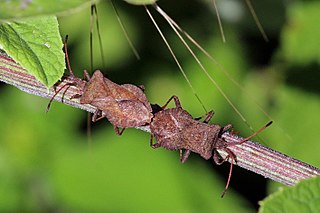
Coreus marginatus is a herbivorous species of true bug in the family Coreidae. It is commonly known as the dock bug as it feeds on the leaves and seeds of docks and sorrels. It is a medium-sized speckled brown insect, between 13 and 15 mm long as an adult, with a broad abdomen. It occurs throughout Europe, Asia and northern Africa. It is often found in dense vegetation, such as hedgerows and wasteland.
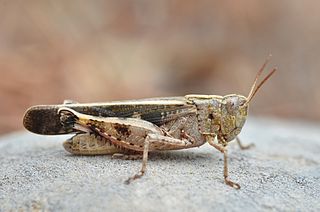
Aiolopus strepens is a species of grasshopper belonging to the family Acrididae, subfamily Oedipodinae.
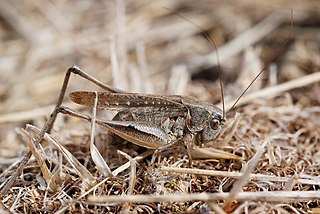
Platycleis is a genus of bush crickets described by Fieber in 1853, belonging to the subfamily Tettigoniinae. The species of this genus are present in Europe, North Africa and temperate Asia.

Yersinella raymondii, common name Raymond's bush-cricket, is a species of "katydids crickets" belonging to the family Tettigoniidae subfamily Tettigoniinae. The scientific name Yersinella comes from the name of the entomologist who has described the species in 1860.

Tetrix ceperoi, Cepero's groundhopper, is a member of the family Tetrigidae and is very similar to common grasshoppers. Grasshopper is defined as a "plant eating insect with long hind legs that are used for jumping and for producing a chirping sound". However, unlike the common grasshopper, the wings of T. ceperoi extend beyond its pronotum. The front wings have evolved throughout history to be stumps, and the back wings are very well developed. Thanks to the front wings only, T. ceperoi is capable of flying. Furthermore, T. ceperoi sports wide shoulders while covering its narrow abdomen beneath the pronotum. T. ceperoi are classified as Orthoptera, which describes crickets, grasshoppers, and locusts. Furthermore, these Orthoptera have incomplete metamorphosis, which also affects sexual dimorphism later. T. ceperoi reach an average length of about 10 millimetres (0.39 in). T. ceperoi is a multi-coloured ground dweller with the ability to blend into its surroundings. The ability of T. ceperoi to be different colours makes it able to evolve colour schemes better adapted to specific habitats. This cryptic nature of their outer layer provides protection from predators as it is able to blend into its surroundings. T. ceperoi is diurnal, which means it is solely active in the daytime. However, although it is diurnal, it continues to hibernate during a late nymphal instar or later on in life as adults.

Conocephalus fuscus, the long-winged conehead, is a member of the family Tettigoniidae, the bush-crickets and is distributed through much of Europe and temperate Asia. This bush-cricket is native to the British Isles where it may confused with the short-winged conehead. These two species are phenotypically similar; however, the distinguishing factor between the two is the fully developed set of wings the long-winged conehead possesses that allows for flight. In the short-winged coneheads the hind wings are shorter than the abdomen, causing the wings to be vestigial and the species is incapable of flight. For this reason it is hard to discriminate between the two species during the early stages of their life cycle before the wings have fully developed. The colouration of the conehead is typically a grass green with a distinctive brown stripe down its back, though there are some brown phenotypes.

Pholidoptera griseoaptera, the dark bush-cricket, is a flightless species of European bush-cricket; it is the type species of its genus with no subspecies.

Barbitistes obtusus, the southern saw-tailed bush-cricket or Alpine saw bush-cricket, is a species of bush crickets in the subfamily Phaneropterinae.

Antaxius pedestris is a species of "bush crickets" belonging to the family Tettigoniidae. It was originally described by Johan Christian Fabricius under the scientific name of Locusta pedestris.
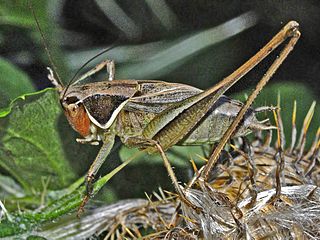
Sepiana sepium, common name sepia bush-cricket, is a species of bush crickets belonging to the tribe Platycleidini and genus group Platycleis. It is the only species within the monotypic genus Sepiana.
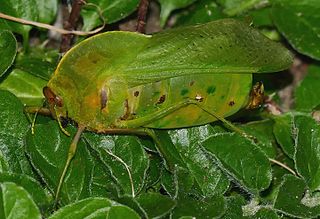
The Pneumoridae are a family of nocturnal short-horned grasshoppers in the order Orthoptera, commonly known as the bladder grasshoppers and the sole representative of the superfamily Pneumoroidea. Their centre of diversity is in southern Africa, but one species occurs as far north as South Sudan. Most adult males acquire an inflated abdomen, a specialization for amplified sound production, which is likely its primary function. Most genera display striking sexual dimorphism, and several species exhibit a dual male phenotype.
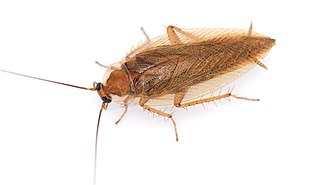
Ectobius vittiventris, the amber wood cockroach or amber forest cockroach, is a species belonging to the order Blattodea and is a type of wood cockroach originally from southern Europe. It is completely harmless to humans and is not a storage pest, as it only feeds on decomposing plant material and perishes within a few days in human dwellings due to a lack of food. Its original range was south of the Alps, but is now permanently established north of the Alps and in southern Germany.

Cyphoderris strepitans, the sagebrush cricket or sagebrush grig, is a one of only a few surviving species in the family Prophalangopsidae. Three of these species are in the genus Cyphoderris and all three are endemic to North America. C. strepitans name is from the Latin word 'strepitans' which means 'making a great noise', refers to their calling song during the mating season.

Platycleis albopunctata is a species of European bush cricket in the tribe Platycleidini.

Acanthaspis quinquespinosa is a species of assassin bug found in India, Sri Lanka, Myanmar, Nepal and Tibet. It is a predator, and both nymphs and adults feed on termites, beetles, caterpillars and other insect prey.





















